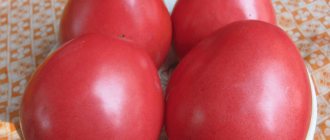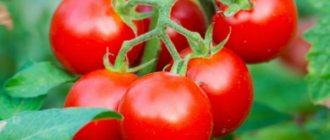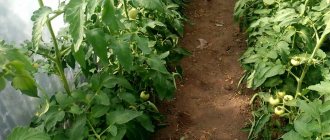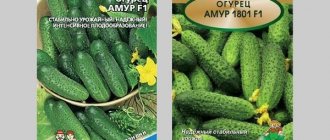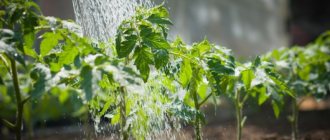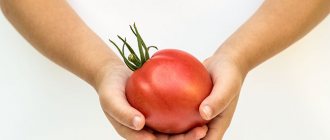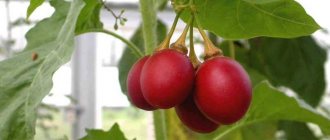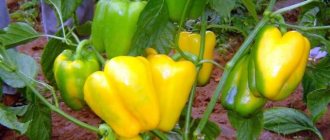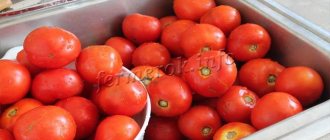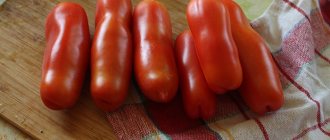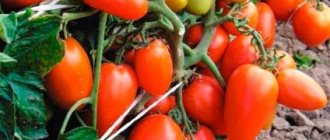Eggplant King of the North f1 reviews, photos, characteristics and description of the variety, which are presented in this article, are distinguished by cold resistance, ease of care and abundant fruiting even in unfavorable weather conditions.
F1 in the name of the variety means that the eggplant variety King of the North belongs to the first generation hybrids. This is the only disadvantage of this variety, since to grow it you need to buy seeds from the originator.
Description and characteristics of the variety
King of the North F1 is one of the new hybrids that has gained great popularity among Russian gardeners.
- Early. Ripe fruits appear on the bush 90-100 days after seed germination.
- Suitable for cultivation in open ground, greenhouses and greenhouses. The hybrid was bred specifically for cultivation in Siberia, the Urals, the Far East and other regions.
- The bush grows up to 55-70 cm in height. The stem is powerful and does not require garter. However, when growing in a greenhouse, it is better to tie the bushes to supports or a trellis, as they can grow up to 1 m.
- The stems are bright purple. The peduncle is without thorns.
- The leaves are medium-sized with purple veins.
- A lot of flowers of a soft lilac hue are tied.
- Fruits within 60-75 days. Until the end of August in open ground and until the end of September - in a greenhouse or greenhouse.
- Productivity is high. Even under unfavorable conditions, 1 sq. a meter of planting yields about 15 kg of vegetables. On 1 bush up to 12 fruits weighing about 0.3 kg are formed. With proper agricultural technology, the yield can be up to 22 kg per 1 sq. meters.
- Resistant to flexible diseases, even in unfavorable weather conditions. Practically not susceptible to powdery mildew, late blight and rot.
- Easy to care for. The bushes bear fruit well even in bad weather. The seedlings tolerate transplantation well and quickly adapt to new conditions.
Care
Agricultural technology includes regular watering, loosening the soil, mulching, removing weeds and applying fertilizers. The side shoots of the plant are removed up to the first inflorescence, as well as excess ovaries, leaving no more than 6-8 fruits. Regular care of the plant will not only contribute to its high-quality growth, but will also prevent the occurrence of diseases and pests.
The main enemy of the King of the North is the Colorado potato beetle. To prevent it from attacking plantations, it is necessary to follow the rules of crop rotation and remove larvae and adults (even single ones) as soon as they appear on the bushes.
Watering
There is no need to water the beds abundantly. However, it is necessary to ensure that the soil around always remains moderately moist. After watering, loosen the soil to allow air circulation. This will also avoid the formation of a soil crust on which various parasites like to lay eggs.
Bushes should be watered depending on the weather. If the summer is rainy, then there is no need to add additional water. An excess of moisture also negatively affects the crop, as does its lack. With excessive watering and high humidity, late blight can develop, however, the King of the North has increased immunity to it.
Related article:
Ten mistakes when growing eggplants
Fertilizers
Fertilizing is applied approximately twice per season. The first portion of fertilizers is applied 1.5-2 weeks after transplanting the seedlings for permanent residence. For this purpose, organic solutions with a high nitrogen content are used. This element is especially important at the beginning of the development of the bush. When flowers and ovaries appear, nitrogen should no longer be added. Now the plant needs phosphorus and potassium, so it is recommended to use fertilizers such as superphosphate and potassium sulfate.
Fertilizing is applied no more than once every two weeks. The frequency of their application will depend on the quality of the soil in the garden bed, how the bush grows (slowly or actively), whether any deviations are observed (premature yellowing of leaves, their falling, lethargy, etc.). If the eggplants develop normally, then there is no need to fertilize frequently.
Fruit characteristics
- The fruits are highly elongated and cylindrical in shape.
- They grow up to 20–30 cm in length and 6–7 cm in diameter. Some specimens grow up to 40–45 cm in length.
- The average weight of 1 eggplant is 300–350 g.
- The skin is glossy, dark purple, thin.
- The pulp is white, tender, juicy, without streaks.
- Great taste, no bitterness.
- Contain a large amount of calcium, iron, phosphorus.
- Stored for 30 days at a temperature of 1–2 degrees Celsius and relative air humidity of 85–90%.
- Resistant to long-term transportation.
Description of the hybrid King of the North F1, its characteristics, growing region
Eggplant King of the North F1 appeared recently; it is still not included in the State Register of Breeding Achievements; the regions for its cultivation are not legally defined. However, all its known properties suggest that this hybrid can be planted wherever eggplants can, in principle, be grown. It is distinguished by its high yield of beautiful fruits and amazing resistance to cold weather.
King of the North F1 is an early ripening hybrid, suitable for cultivation both in greenhouse conditions and in unprotected soil. According to numerous observations by gardeners, the first fruits reach technical ripeness 110–120 days after sowing the seeds. It was bred for the northern regions of our country, which are part of the risky farming zone, but is grown everywhere.
The bushes are quite tall, 60–70 cm, but often, especially in greenhouses, they reach 1 meter. However, they are not always tied up: if there are not too many fruits set, the bush holds them on its own. This is all the more justified by the fact that the fruits are mainly located in the lower part of the bush, and even lie on the ground. The leaves are medium sized, green, with lighter veins. The flowers are small, purple with a lilac tint. The stalks are thornless, which makes harvesting easier.
King of the North F1 bushes are compact, but the fruits often lie on the ground
The overall yield is above average, up to 10–12 kg/m2. You can get up to 12 fruits from one bush, but their setting and ripening is not simultaneous, it lasts for 2–2.5 months. In open ground, fruiting lasts until the end of summer; in greenhouses it extends into September.
The fruits are elongated, almost cylindrical, slightly curved, often growing in bunches, like bananas. Their length reaches 30 cm, but since they are thin (no thicker than 7 cm in diameter), the average weight does not exceed 200 g. Record holders grow to 40–45 cm in length and 300–350 g in weight. The color is dark purple, almost black, with a strong shine. The pulp is white, has an excellent but ordinary eggplant taste, without bitterness, but also without any interesting features.
The purpose of the crop is universal: the fruits are fried, stewed, canned, frozen, and made into caviar. At a temperature of 1–2 °C and a relative humidity of 85–90%, the fruits can be stored for up to a month, which is a very good indicator for eggplants. They are normal and transported over long distances.
Video: King of the North F1 at the dacha
Appearance
Both the hybrid bush and its ripe fruits look very elegant. Of course, this only happens in the case of conscientious care, when the bushes are formed correctly, watered and fed on time, and the fruits are allowed to ripen normally and are not left on the bushes.
The fruits of this eggplant sometimes look like bunches of bananas, but sometimes they grow singly
Advantages and disadvantages, features, differences from other varieties
King of the North F1 has not been known for very long, but has already earned a lot of positive reviews. True, sometimes they are contradictory: what some gardeners consider an advantage, others consider a disadvantage. So, you can read that the fruits of the hybrid have an excellent taste, but without frills or piquancy. Nearby, other lovers write something like: “Well, how great is it if it doesn’t differ in any way from the taste of other eggplants?”
Among its undoubted advantages are the following.
- Highest cold resistance. It can grow and bear fruit in seasons that are cold throughout and characterized by sharp temperature fluctuations. At the same time, unlike most eggplant varieties, it does not tolerate heat well, which hinders its cultivation in the southern regions. But the conditions of the middle zone, Siberia, and the North-Western region are quite suitable for him. Even at temperatures close to 0 ° C, the hybrid bushes are not damaged.
- Good seed ripening and, as a consequence, their subsequent high germination rate. It is believed that for eggplants the germination rate of prepared seeds is about 70% - very good. King of the North, unlike other varieties, shows these percentages for dry seeds.
- Unpretentiousness to growing conditions. Some stages of agricultural technology when growing this hybrid can be skipped altogether. The bush does not require gartering or shaping. Its seedlings take root well both in greenhouses and in open ground.
- Increased resistance to disease. Such dangerous diseases as powdery mildew, various types of rot, late blight are uncharacteristic for it even in cold and wet years.
- Good taste and versatility of fruit use. It is often said that its aroma has too little mushroom notes, but it is not a mushroom! (Although, of course, Emerald F1 is also not a mushroom, but it tastes like mushroom caviar). But in general, the taste of the fruit is no worse than that of most other varieties.
- High commercial quality, safety and transportability of fruits. These properties make the hybrid commercially profitable and allow it to be grown not only on private farms.
- High yield. On the forums you can find messages that only 5 kg were obtained from 1 m2. Of course, 5 kg is not very little, but more often there are reports of 10–12 kg, or even higher. Such productivity is associated with long-term flowering and can, of course, be achieved only if a long summer regime is created.
Since nothing is without flaws, the King in the North also has them. True, these are mostly relative disadvantages.
- Not everyone likes long fruits. This manifests itself both in cooking and in growing. Yes, for some dishes thick, barrel-shaped or pear-shaped fruits are more convenient. Well, what kind there are... In addition, because of their length, they often lie on the ground and get dirty. But you can combat this by placing a layer of dry mulch or even, as in the case of pumpkins, plywood or planks under the fruits.
- Inability to reproduce independently. Yes, the King of the North is a hybrid, and there is no point in collecting seeds from it; you have to buy it annually. But, unfortunately, this misfortune befalls summer residents not only in the case of eggplants.
- Not everyone likes a simple taste, without any frills. Indeed, this hybrid has a standard eggplant taste. But he is completely devoid of bitterness, which, in turn, is rather a virtue.
Advantages and disadvantages
The hybrid has many advantages, including the following:
- Frost-resistant. The hybrid withstands temperature changes and light frosts, which occur even at the beginning of summer. At the same time, productivity indicators are maintained.
- Good seed germination. Even without preliminary preparation, 70% of planting material germinates.
- Easy to care for. The bush does not require shaping and does not need to be tied up in open ground. The seedlings tolerate transplantation into soil well and quickly adapt to a new location.
- Resistant to fungal diseases that often affect eggplants.
- Great taste. The pulp of the hybrid is tender, without bitterness.
- Good keeping quality.
- Beautiful presentation.
- High yield.
Some gardeners consider the elongated shape of the fruit to be a disadvantage of the variety. Also, due to their length, eggplants often get dirty when they fall to the ground.
The main disadvantage is the impossibility of growing these eggplants from independently collected seeds, since they do not retain varietal qualities.
Planting in the ground and preparation for it
Seedlings are hardened off before planting in the ground. To do this, the pots are first taken outside for 2-3 hours, then this time is gradually increased to 10 hours. Pots should not be placed in a draft.
The place for planting eggplants should be open, sunny and protected from the wind. You can’t plant blue ones in places where nightshades grew before.
Planting in the ground is carried out when the average daily temperature is at least 20 degrees. This usually occurs in mid-June. By this time, each sprout should have 7-8 leaves. If the seedlings have buds or flowers, this is not an obstacle to planting in open ground.
See also
Description of the Prince eggplant variety, its characteristics and productivityRead
The bushes are planted at a distance of 50 cm from each other, the distance between the rows should be about 60 cm. The depth of the holes is 15 cm.
If the seedlings were planted in peat pots, then the eggplants are dropped into the holes along with the container.
Features of cultivation
The hybrid King of the North is grown by seedlings.
When and how to plant eggplant seedlings
It is better to sow the seeds in peat pots, so as not to have to pick them later. They operate according to the following algorithm:
- Seeds and soil are disinfected (the soil is steamed in a water bath or frozen).
- The seeds are hardened and treated with a growth stimulant (Epin, Zircon, Potassium Humate).
- Sowing seeds in peat pots.
- After emergence of seedlings, the air temperature in the room is lowered to 16–18 degrees for 7 days.
- Next, the temperature is kept within 23-25 degrees.
- Water with moderately warm, settled water.
- Seedlings are hardened off for 10-14 days before planting in a permanent location. Plants are kept on the balcony for several hours, this period is gradually increased. This way the seedlings will get used to temperature changes and direct sunlight.
Feeding seedlings
Fertilizers are applied 2-3 times.
For fertilizer you can use the following products:
- Dilute 30 grams of potassium nitrate in 10 liters of water. This feeding option is universal; it is suitable for open soil and greenhouses.
- Fertilizer "Kemira-Lux". For 10 liters of water you need 20-30 grams of fertilizer.
- 5 grams of ammonium nitrate, 15 grams of superphosphate and 10 grams of potassium sulfate per 10 liters of water.
Landing in the ground
Seedlings are ready for planting in the ground at the age of 60–70 days. The beds are prepared in advance. The soil is dug up well and humus and ash are added to the holes, as well as some mineral fertilizers. It is necessary to plant eggplants in open and closed ground when the soil warms up to 15 degrees. If the average daily air temperature has not warmed up to 18–20 degrees, the crops are covered with film. The seedlings are transferred to the holes without deepening them, so as not to disturb the root system. Planting pattern: 40*60 cm, no more than 5-6 bushes per 1 m2.
For more information on how to grow eggplant seedlings, read the article: When and how to plant eggplant seedlings: step-by-step instructions
Harvesting and storage
We recommend reading our other articles
- The best red varieties of apples with descriptions and photos
- Technology for growing winter wheat
- Green walnut jam
- Pear variety Conference
The King of the North F1 eggplant harvest ripens in July or early August. Fruiting can be extended; if the weather is warm, fruits can be collected over several weeks. They are harvested when the fruits are fully ripe; ripeness is usually easily determined by the length and rich dark color of the glossy peel.
Fresh eggplants are stored well. The King of the North keeps in the refrigerator for 1.5-2 weeks. But usually they are either canned or frozen. To freeze eggplants, simply cut them into slices, strips or cubes, then put them in a container and place them in the freezer. Fresh eggplants of this variety are suitable for salads, grilling, frying, boiling, and pickling.
Diseases and pests
The variety is resistant to fungal diseases such as powdery mildew, late blight, and rot . Disinfecting seeds before sowing is sufficient protection against fungus. But if the summer is damp and cool, then the plants are periodically treated with wood ash or crushed chalk.
The main enemies of the variety are aphids and spider mites. Aphids stick to young shoots and buds, feeding on the sap of the plant; the affected parts first turn pale, curl, and then dry out. Infected bushes are treated 2 times a day with an infusion of onion peels or garlic for a week. Aphids do not like strong odors, so it is good to repel them with the aromas of tomatoes, marigolds, and mustard powder.
Spider mites cover the young parts of the plant with a translucent web, the affected areas turn yellow and dry out. In this case, special drugs will help: Fitoverm, Vertimek, Apollo. Treatment is carried out 3-4 times a day, every 5-7 days. It is recommended to change the drug periodically.
Slugs feed on the pulp of fruits. You can get rid of slugs using store-bought drugs Meta and Groza. It is also useful to surround the bushes with pine needles or sand, which will serve as a natural protection against slugs.
Preparing the site for planting
Preparing the soil in the fall
To grow King of the North eggplant with ideal characteristics, you need to properly prepare the soil. The description of the variety indicates that King of the North category f1 eggplants need good lighting, so they need to be planted in areas that receive a lot of sunlight. In the fall, you should dig up the garden and remove the roots of all weeds from it. This will clear the soil of elements that take away many useful substances from it.
If the soil acidity level exceeds 6%, it is necessary to add lime to it while digging the garden. There should be about 4 kg of lime per 1 m2. In the spring, a month before planting, it is recommended to apply phosphorus fertilizers to the soil, which will saturate it with the necessary beneficial microelements that contribute to the better development of eggplants. An ideal fertilizer would be mullein or humus. For every 1 m2, at least 6 kg of fertilizer should be applied.
